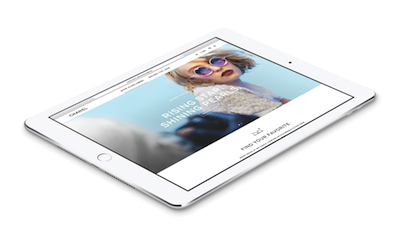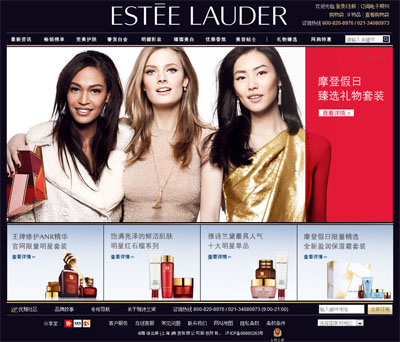 Photo courtesy of Bloomingdale's
Photo courtesy of Bloomingdale's
Fashion ecommerce has shown no signs of slowing, with online purchases expected to more than double to $3.5 trillion by 2019, and with that, fraudulent sales have kept up the pace, according to a new report by Riskified. Riskified’s “Fraud in Online Fashion” report is geared toward ecommerce retailers selling premium and luxury fashion brands in the online space. For an industry that counted $8.5 billion in online sales for 2015, a figure expected to double by 2020, online retailers must be aware of the increasingly difficult challenges and risks the counterfeiting underworld presents.
"Today, more then ever before, consumers are willing (and often prefer) to purchase luxury items online and luxury brands want to make sure that they're providing the best possible online shopping experience for their customers," said Andy Freedman, CMO at Riskified. "With online fraud for luxury fashion more than double that of consumer fashion, luxury brands are on high-alert and overly restrictive with their online order approvals.
"While being watchful for fraudulent transactions is critical, equally important is ensuring that you aren't rejecting a large group of legitimate customers whose business and loyalty cannot be undervalued," he said. "Currently, luxury brands' fraud management systems are incorrectly identifying legitimate orders as fraudulent.
"The Fraud in Online Fashion report shows how prevalent and detrimental this is on their revenue and customers - especially the millennials and high-income customers, which are the most impacted by having their orders falsely declined."
Riskified works with a number of clients in the apparel and accessories space and has used its own data insights to compile the information used in the report, including consumer fashion and luxury fashion sites. Finding fraud Staying ahead of fraud has presented challenges for fashion retailers online, especially given the rapidness of the fashion calendar, its massive output, high demand from consumers and the quickness in which current style trends evolve. The way the fashion industry operates has resulted in legitimate and fraudulent buying patterns. For fraud protection and prevention, retailers must take a complex and multi-faceted approach to curbing these sales without negatively impacting revenue goals and new market penetration. Riskified notes that when thinking of fraud, fashion industry executives must enact effective consumer validation measures that do not add “friction” to legitimate shopping experiences. Retailers must also be aware of declining legitimate orders, as doing so may insult consumers and lead to significant losses. As more brands begin to offer international ecommerce, the balance between validation and prevention measures will accelerate in importance. For this, brands need to update fraud management systems and processes to handle the influx of cross-border transactions, a market estimated to reach $1 trillion in sales by 2020. Chanel ecommerce sunglass shop
This is important for the fashion industry, as 61 percent of cross-border online purchases have been for apparel in the last year.
Riskified suggests that fashion merchants should approve at least 90 percent of online orders, showing that the fraud rate for luxury fashion is below 5 percent. Although the risk of fraud in luxury fashion orders online is more than double that of mass fashion, Riskified approved 90 percent of transactions in the space.
Within the 10 percent declined, retailers are surely rejecting legitimate consumers, a mistake that can be damaging to a brand’s image and result in a drop in consumer interest. Riskified cited a report by Javelin that showed that 58 percent of high-income cardholders ceased shopping with a retailer after their transaction was rejected and flagged as fraudulent.
Merchant payment solutions are generally unremarked upon by the public, but as soon as a variable goes awry consumers can quickly lose confidence.
For luxury retailers that deal with high-spending clientele and lean on hard-earned reputations, ensuring the safety of customer data is especially important. However, misinformation about payment solutions and delayed implementation of advanced infrastructure makes the landscape seem more ominous than it should (see story).
Chanel ecommerce sunglass shop
This is important for the fashion industry, as 61 percent of cross-border online purchases have been for apparel in the last year.
Riskified suggests that fashion merchants should approve at least 90 percent of online orders, showing that the fraud rate for luxury fashion is below 5 percent. Although the risk of fraud in luxury fashion orders online is more than double that of mass fashion, Riskified approved 90 percent of transactions in the space.
Within the 10 percent declined, retailers are surely rejecting legitimate consumers, a mistake that can be damaging to a brand’s image and result in a drop in consumer interest. Riskified cited a report by Javelin that showed that 58 percent of high-income cardholders ceased shopping with a retailer after their transaction was rejected and flagged as fraudulent.
Merchant payment solutions are generally unremarked upon by the public, but as soon as a variable goes awry consumers can quickly lose confidence.
For luxury retailers that deal with high-spending clientele and lean on hard-earned reputations, ensuring the safety of customer data is especially important. However, misinformation about payment solutions and delayed implementation of advanced infrastructure makes the landscape seem more ominous than it should (see story).
 Consumer making an online purchase via credit
In addition, Riskified found that not all products are subjected to the same amount of fraudulent purchases via ecommerce merchants. Watches, sneakers and jeans have the highest rate of fraud online, but underwear, swimwear, jewelry and footwear are deemed the “safest” of fashion items because they are not targeted as often.
Considering that the counterfeit handbag market looms over the heads of many fashion brands, only 2.3 percent of handbag purchases are targeted by fraudsters. The high-end watch market is a different story, with 9.92 percent of purchases being fraudulent, though jewelry is only subjected to fraud for 1.09 percent of transactions.
Luxury ecommerce players should also be aware that the more items in a consumer’s cart, the more likely the transaction is rife with fraud. To this point, Riskified has found that when luxury fashion orders have six or more items in a cart, the purchase is 10 times more likely to be fraudulent than purchases of a single item.
But purchases with many items should not immediately be suspected as fraud, as the relationship is not linear and brands should not jump to conclusions on numbers alone. For instance, orders with two items are 1.3 times riskier than single item orders, but orders with five products have less of a risk than those with four items.
Consumer making an online purchase via credit
In addition, Riskified found that not all products are subjected to the same amount of fraudulent purchases via ecommerce merchants. Watches, sneakers and jeans have the highest rate of fraud online, but underwear, swimwear, jewelry and footwear are deemed the “safest” of fashion items because they are not targeted as often.
Considering that the counterfeit handbag market looms over the heads of many fashion brands, only 2.3 percent of handbag purchases are targeted by fraudsters. The high-end watch market is a different story, with 9.92 percent of purchases being fraudulent, though jewelry is only subjected to fraud for 1.09 percent of transactions.
Luxury ecommerce players should also be aware that the more items in a consumer’s cart, the more likely the transaction is rife with fraud. To this point, Riskified has found that when luxury fashion orders have six or more items in a cart, the purchase is 10 times more likely to be fraudulent than purchases of a single item.
But purchases with many items should not immediately be suspected as fraud, as the relationship is not linear and brands should not jump to conclusions on numbers alone. For instance, orders with two items are 1.3 times riskier than single item orders, but orders with five products have less of a risk than those with four items.
"For every transaction, there are two stories that can be told - the story of a legitimate consumer and that of a fraudster," Mr. Freedman said. "Riskified, takes a holistic approach to fraud prevention. We've spent years building our proprietary technology, using intelligent automation, machine learning and advanced fraud detection methods.
"But our true value is shown through our ability to drive top-line sales impact for our luxury clients - something typically not counted on by existing risk management tools or solutions," he said. "As an recent example, a multibillion dollar, global luxury fashion brand saw overall sales grow over 1 percent, using Riskified to drastically reduce the number of transactions being declined by their existing fraud prevention process."
Opportunity knocks As cross-border ecommerce continues to be an important aspect of the fashion industry, brands should be aware of where purchases are coming from. Eighty-four percent of Chinese consumers, for instance, made online cross-border purchases, primarily from United States-based retailers. With a third of Chinese consumers making a purchase from a foreign Web site, 43 percent of those cross-border transactions were made for apparel and accessories. These dealings, as with a number of other countries, do come with risks for online retailers. Riskified’s data shows that orders paid for with Chinese credit cards for shipping outside of China have a fraud rate of 3.5 percent. Luxury purchases made with Chinese credit cards but shipped to the U.S. are seen as safest at a fraud rate of 1.04 percent, while luxury orders paid with a Chinese credit card and shipped to any non-Chinese is riskier, at 1.58 percent. Estee Lauder's Chinese ecommerce site
The slow adaptation of ecommerce in China is linked to the risk of fraudulent charges, lapse in service and fear of counterfeit goods.
A number of luxury brands have launched ecommerce sites in China within the past year, but online shopping still feels like risky business to many of the country’s consumers, according to a recent report by FDKG.
FDKG’s “Luxury Insights China 4th Quarter” report explained that with less regulation of online sales in China, consumers may have to endure a drawn out dispute if items are not delivered as promised, making each purchase a consideration of not only spending budget, but a weighing of how much can comfortably be lost. While some may still opt for an in-store purchase, a growing interest in online shopping within China is evident in the $14 billion in transactions during Single’s Day Nov. 11 (see story).
By turning away Chinese credit cards, and therefore the consumer attached to it, merchants are refusing a high amount of revenue in the fashion sector. Essentially, retailers should be open to accepting luxury and consumer fashion orders paid for with Chinese credit cards and shipment to non-Chinese addresses, in the U.S. or otherwise, unless there is evidence to decline the sale.
Estee Lauder's Chinese ecommerce site
The slow adaptation of ecommerce in China is linked to the risk of fraudulent charges, lapse in service and fear of counterfeit goods.
A number of luxury brands have launched ecommerce sites in China within the past year, but online shopping still feels like risky business to many of the country’s consumers, according to a recent report by FDKG.
FDKG’s “Luxury Insights China 4th Quarter” report explained that with less regulation of online sales in China, consumers may have to endure a drawn out dispute if items are not delivered as promised, making each purchase a consideration of not only spending budget, but a weighing of how much can comfortably be lost. While some may still opt for an in-store purchase, a growing interest in online shopping within China is evident in the $14 billion in transactions during Single’s Day Nov. 11 (see story).
By turning away Chinese credit cards, and therefore the consumer attached to it, merchants are refusing a high amount of revenue in the fashion sector. Essentially, retailers should be open to accepting luxury and consumer fashion orders paid for with Chinese credit cards and shipment to non-Chinese addresses, in the U.S. or otherwise, unless there is evidence to decline the sale.
"Cross-border ecommerce is already a $1 trillion industry and has become a market that luxury brands simply can no longer ignore," Mr. Freedman said. "The truth is that while expanding into new markets can seem daunting, Riskified's experience reviewing millions of transactions across the globe has taught us that the world isn't such a scary place and customer demand for new brands is growing exponentially.
"This is particularly true for U.S. retailers, where roughly 50 percent of all ecommerce purchases made by shoppers on a site outside their home country were placed on a U.S. ecommerce site," he said. "Riskified has been able to help hundreds of global luxury brands address concerns around global expansion, ensuring that new customers experiencing brands are delivered a frictionless shopping experience."
